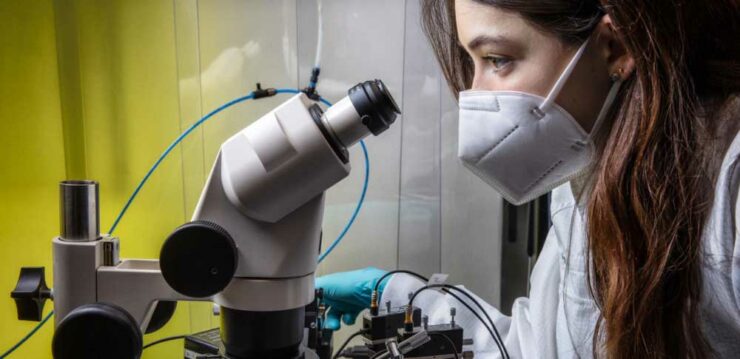Even today, women remain underrepresented in science and in research-driven industry. At Fraunhofer IZM, women account for 29.3 % of all employees, with a greater proportion of women in non-scientific (50 %) than in science jobs (23.8 %).* To counter this, several programs and initiatives have been put in place to further the representation of women and promote equal opportunities at our Institute and in the Fraunhofer Society at large.
For example, Fraunhofer IZM specifically supports female students with the “Women in Science” program, and the internal “Networking Breakfast: Women at IZM” events were launched in 2023. The response has been very positive. At the beginning of February, more than 50 women from the Institute’s three locations at Berlin, Dresden-Moritzburg, and Cottbus came together for in-person or virtual networking opportunities.
We launched our RealIZM blog more than three years ago with the mission to make the research projects and output of Fraunhofer IZM employees more visible and to give an insight into their everyday work.
The idea to start this blog came from two former colleagues of our PR & Marketing team. Today, we have published more than 70 posts, and 13 of them were written in collaboration with female scientists from Fraunhofer IZM. To mark the International Women’s Day 2023, we have selected our five favorite pieces with female protagonists.
Dr. Manuela Junghähnel:
Wafer-level system integration on 300 mm – The core competence of Fraunhofer IZM-ASSID
- Developing, testing, optimizing, and manufacturing innovative products in small series for industry – this is the Fraunhofer philosophy brought to life with packaging technologies for 300 mm wafers at Fraunhofer IZM-ASSID. Dr. Manuela Junghähnel, the site manager in Dresden, explains this unique selling point in an interview with RealIZM. Read the full article here.
Dr. Vanessa Zamora Goméz:
Adhesive-free fused silica fiber joints made possible by direct laser welding
- Fused silica is a special material that has many advantages for creating interconnections in photonic integrated circuits. Thanks to the perseverance of Dr. Vanessa Zamora Goméz and her team, Fraunhofer IZM has developed a new laser welding process that also uses cheaper CO2 lasers. Read here why this could be something of a revolution for attaching optical fibers to PiC. Read the full article here.
Jana Rückschloss:
The Hunger of Data Centers for Critical Raw Materials – And How we Counter it
- How will emergent technologies change the demand for raw materials in their possible use cases, such as data centers? What about information about resource efficiency or possible substitutes for each technology? Jana Rückschloss, researcher at Fraunhofer IZM, gives RealIZM an insight into the interesting world of raw materials for data centers. Read the full article here.
Prof. Dr. Vasiliki Giagka and Andrada Iulia Velea:
A Revolution for Neural Implants: Wireless Charging and Nerve Stimulation
- The treatment of chronic autoimmune diseases is no longer limited to expensive drugs with undesirable side effects. Neuromodulation has been shown to be effective in treating diseases like rheumatoid arthritis, chronic headaches, asthma, or Parkinson’s disease. Fraunhofer IZM was a partner on the Moore4Medical project, which brought together 66 companies, universities, and research institutes from more than ten countries. The IZM researchers Andrada Velea and Professor Dr. Vasiliki Giagka worked on the means to power implants wirelessly via ultrasound and explored ways to stimulate tissue by using ultrasound for neuromodulation. Read the full article here.
Sigrid Rotzler:
IZM’s In, Dirt’s Out: How to Wash Your E-Textiles
- E-textiles have been around for almost two decades, but they still have not made it in the wider market. One cause of this slow acceptance might be reservations about their usability. Especially for textile-integrated conductor tracks, which promise greater integration into the textile substrates, washability constitutes one of the key challenges. Sigrid Rotzler, head of the Textile Prototyping Innovation Lab at Fraunhofer IZM, researches how certain factors during washing – time, temperature, chemical reactions, and mechanical stresses – affect the reliability of conductor tracks and how the washability of e-textiles can be improved. Read the full article here.
The diversity of Fraunhofer IZM’s staff is matched by the diversity of the research our scientists are working on. And there are many more interesting projects ahead. Subscribe to the RealIZM newsletter!
*As of: 12/31/2021 Presentation of the Equal Opportunities Officer at Fraunhofer IZM





Add comment